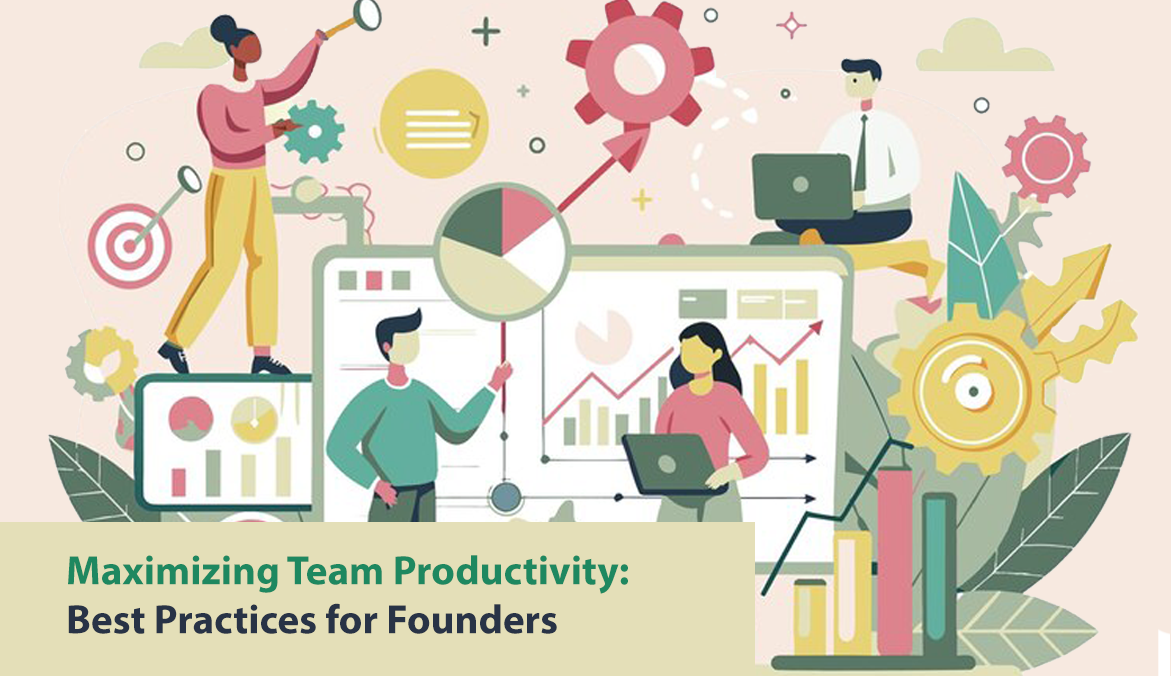Set Clear Goals and Expectations
One of the most effective ways to increase team productivity is to set clear goals and expectations for your team. When everyone knows what they’re working towards, it’s easier to stay focused and motivated. Break down larger objectives into smaller, actionable tasks, and assign them to your team members with specific deadlines. Regularly review progress and adjust goals as necessary to keep everyone on track.
Action Steps:
- Define SMART (Specific, Measurable, Achievable, Relevant, Time-bound) goals.
- Use project management tools to assign tasks and track progress.
- Hold regular check-ins to discuss goals and address any roadblocks.
Foster a Collaborative Environment
Productivity thrives in an environment where collaboration is encouraged. As a founder, it’s your responsibility to create a culture that promotes teamwork. Encourage open communication, provide opportunities for your team members to collaborate on projects, and celebrate successes together. A collaborative environment not only boosts productivity but also fosters innovation and creativity.
Action Steps:
- Implement team collaboration tools like Slack or Microsoft Teams.
- Organize regular brainstorming sessions to encourage idea sharing.
- Recognize and reward team efforts to build a sense of community.
Invest in the Right Tools and Technology
Equipping your team with the right tools and technology is essential for maximizing team productivity. From project management software to time tracking tools, investing in the right resources can streamline workflows, reduce manual tasks, and free up time for more strategic work. Regularly evaluate the tools your team is using to ensure they are meeting your needs.
Action Steps:
- Implement a project management tool like Asana, Trello or Karya Keeper.
- Use time tracking software such as Mera Monitor to gain insights into how time is spent.
- Regularly review and upgrade tools to keep up with industry trends.
Encourage a Healthy Work-Life Balance
While it’s important to push for productivity, it’s equally important to encourage a healthy work-life balance. Overworking can lead to burnout, which ultimately reduces productivity. As a founder, set an example by maintaining a healthy balance yourself and encouraging your team to do the same. Offer flexible working hours, promote regular breaks, and provide support for mental health.
Action Steps:
- Encourage the use of paid time off and mental health days.
- Provide resources for stress management and wellness programs.
- Create a culture that values results over hours worked.
Provide Continuous Feedback and Development
Continuous feedback is key to improving team productivity. Regularly provide constructive feedback to help your team members grow and develop their skills. In addition to feedback, offer opportunities for professional development. Whether it’s through online courses, workshops, or conferences, investing in your team’s growth will pay off in the long run.
Action Steps:
- Implement regular one-on-one meetings to provide personalized feedback.
- Offer training programs and workshops to develop new skills.
- Encourage a growth mindset by promoting learning and improvement.
Streamline Communication
Clear and efficient communication is essential for increase productivity in your team. Miscommunication can lead to mistakes, delays, and frustration. As a founder, work on streamlining communication within your team. Establish clear channels for different types of communication, whether it’s for quick updates, project discussions, or decision-making.
Action Steps:
- Use dedicated communication channels for different purposes (e.g., Slack channels for projects).
- Set guidelines for email and meeting communication to reduce unnecessary interactions.
- Encourage transparency and openness in all forms of communication.
Lead by Example
As a founder, your behavior sets the tone for the rest of your team. Leading by example is one of the most powerful ways to influence productivity. Show commitment to your company’s goals, demonstrate a strong work ethic, and embody the values you want to see in your team. Your leadership style will inspire others to follow suit.
Action Steps:
- Practice what you preach by staying disciplined and focused on your tasks.
- Be approachable and open to feedback from your team.
- Show appreciation for hard work and celebrate wins, big or small.
Prioritize Task Management
Effective task management is crucial to maintaining high productivity levels. Prioritize tasks based on their urgency and importance, and encourage your team to do the same. This approach ensures that critical tasks are completed first, reducing the risk of missing deadlines or getting overwhelmed by less important activities.
Action Steps:
- Use the Eisenhower Matrix to categorize tasks based on urgency and importance.
- Encourage daily or weekly planning sessions to organize tasks.
- Review and adjust priorities regularly to adapt to changing circumstances.
Empower Your Team with Autonomy
Continuous feedback is key to improving team productivity. Regularly provide constructive feedback to help your team members grow and develop their skills. In addition to feedback, offer opportunities for professional development. Whether it’s through online courses, workshops, or conferences, investing in your team’s growth will pay off in the long run.
Action Steps:
- Implement regular one-on-one meetings to provide personalized feedback.
- Offer training programs and workshops to develop new skills.
- Encourage a growth mindset by promoting learning and improvement.
Cultivate a Positive Work Environment
A positive work environment is essential to make a team more productive. Foster a workplace culture that values respect, inclusivity, and recognition. When your team feels valued and appreciated, they are more likely to stay engaged and motivated. A positive environment also reduces stress and improves overall job satisfaction.
Action Steps:
- Recognize and celebrate individual and team achievements.
- Create an inclusive culture where everyone feels heard and respected.
- Address conflicts or negative behaviors promptly to maintain a positive atmosphere.
Advantages of Maximizing Team Productivity as a Founder:
Increased Efficiency:
Work efficiency is the greatest number of tasks and labour accomplished with the least amount of time and effort. Excellent work efficiency can lead to high levels of productivity.Improved morale:
giving employees a choice regarding their development is good for their morale.Increased Revenue:
A highly productive team can help in business growth and increase revenue.Better Decision Making:
Smaller teams have a streamlined decision-making process, resulting in quicker responses to challenges and opportunities.
Conclusion
The different types of rewards are -
- Bonuses-
- Variable Pay
- Stock Options
- Written/Verbal praise
Recognition on the other hand can take a variety of forms. Structured programs can include regular recognition events such as banquets or breakfasts, employee of the month or year recognition, or an annual report or yearbook which features the accomplishments of employees. A job well done can also be recognized by providing additional support or empowering the employee in ways such as greater options of assignments to choose from, increased authority, or naming the employee as an internal consultant to other staff. A point to be noted is that the recognition itself may have a monetary value (such as a luncheon, gift certificates, or plaques), money usually is not given to recognize performance.
- Recognition in the workplace is important as it leads to -
Increase in productivity: Rewarding and recognizing tends to increase employee productivity in the workplace. It makes them go the extra mile. Engagement at work stimulates a spirit of teamwork and acts as a catalyst for high performance. It is important to make sure that the high performers are rewarded and recognized timely.
Stimulating development and career progression of employees: Employees tend to do more when they are recognized and rewarded for good work. It encourages development and career growth since it puts the employee in the position to do more and elevate their work performance. It gives employees morale to do more and exceed the expectations the company has from them.
A sense of satisfaction and morale: Reward and recognition cultivates a positive relationship between employers and employees. The employer will benefit from an empowered employee delivering good results. On the other hand, a recognized and rewarded employee will become confident and satisfied with their work. Enhancing employee morale can contribute to lowering the turnover rate too.
A strong employer brand: Employees talk and share experiences with those of other companies. A company that recognizes and rewards employees builds a positive brand when its employees talk positively about it. Organically, the company becomes recognized for its best HR practice and this can impact the way it works with external stakeholders. The company that recognizes and rewards its employees will not only be known for its productivity but also for its good leadership practice and people management skills.
Identifying the needs of your employees is a crucial step in creating effective employee motivation strategies. It involves understanding what motivates your employees and what challenges they face in the workplace. Conducting surveys, focus groups, or one-on-one meetings with employees can help to gather this information.
Some of the benefits are:
- Better productivity and performance
Motivated employees are high performers that work harder and focus more on creating better outcomes. This makes them more productive, and ultimately, your business becomes more profitable. - Better customer service
Who do you want to serve you? The employee who is doing the bare minimum? Or the person who is motivated to go above and beyond to make your experience great? The answer is clear. - Reduced turnover
Workers who are genuinely motivated to do their job don’t quit. If your employees are happy and motivated to do great work every day, they’re not looking for other jobs—they’re looking for more to do at your workplace. - More innovation
When your employees are motivated and happy, they’ll handle change and uncertainty better. They’ll come up with new, more creative ideas on how to increase productivity, better the customer experience, and more. - Improved employee engagement
A highly-engaged workforce is the key to a healthy bottom line. If you have employees who are not engaged, using some of the simple motivation ideas above could nudge them in the right direction.
 Gift Card ₹999
Gift Card ₹999


